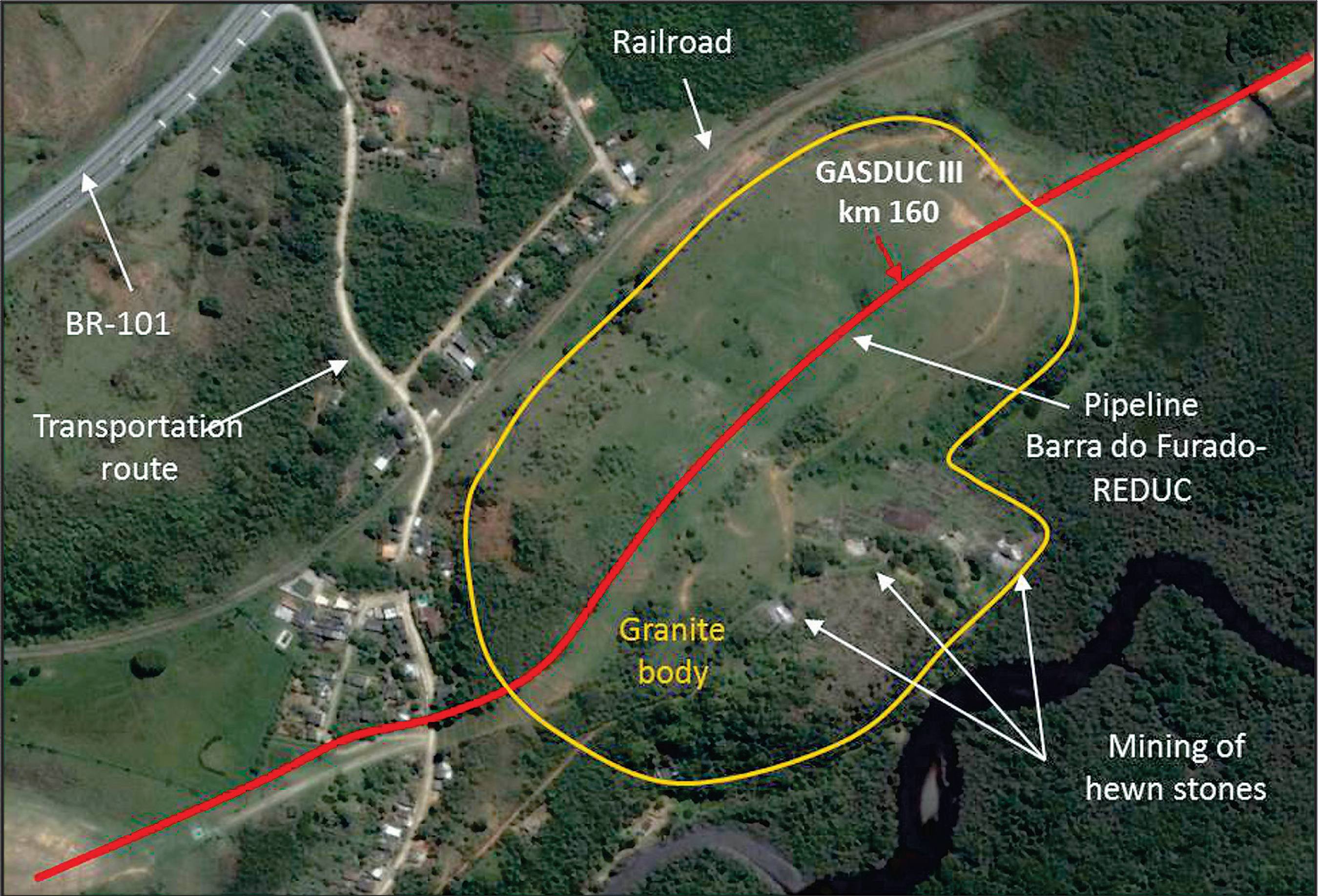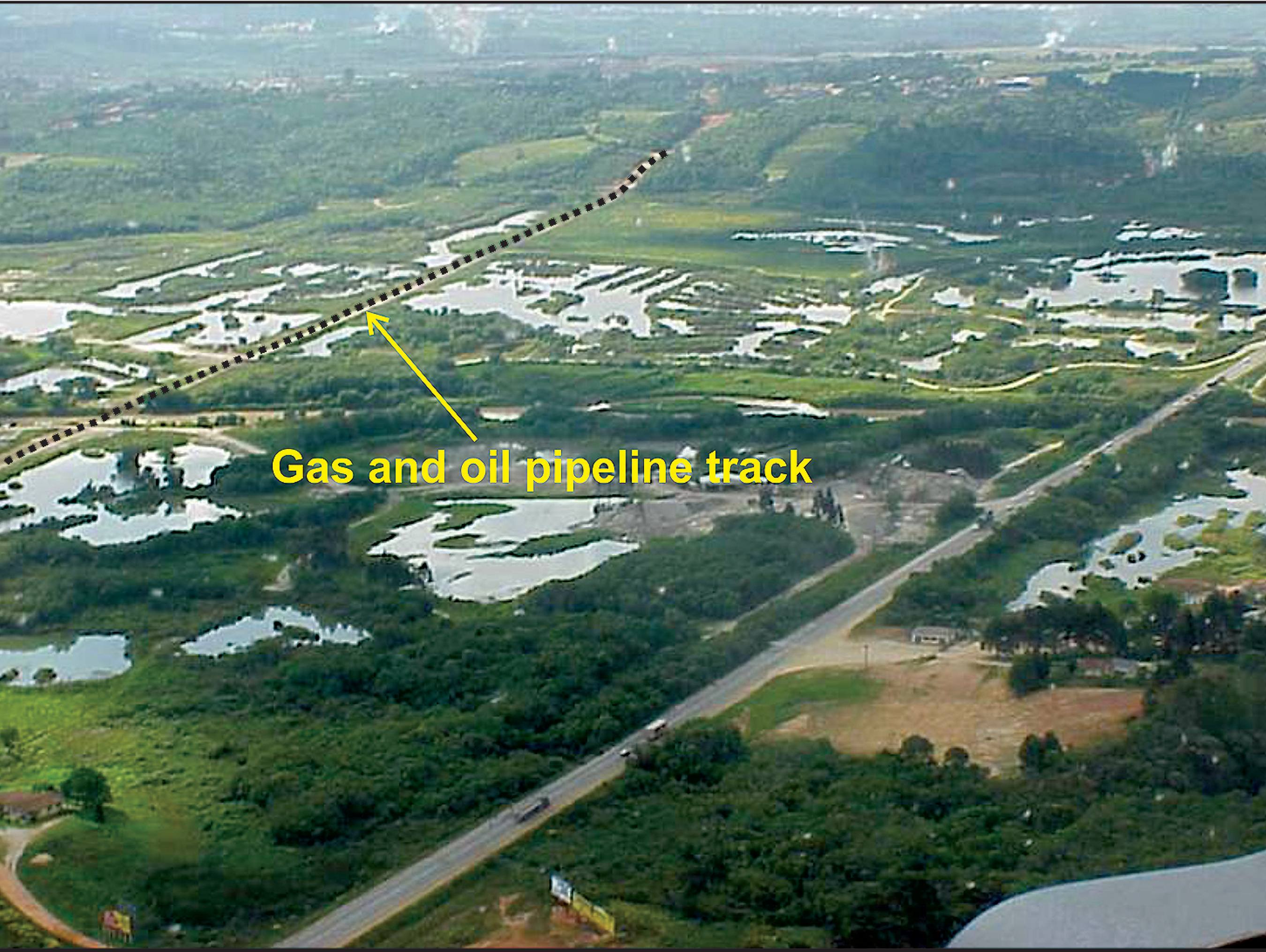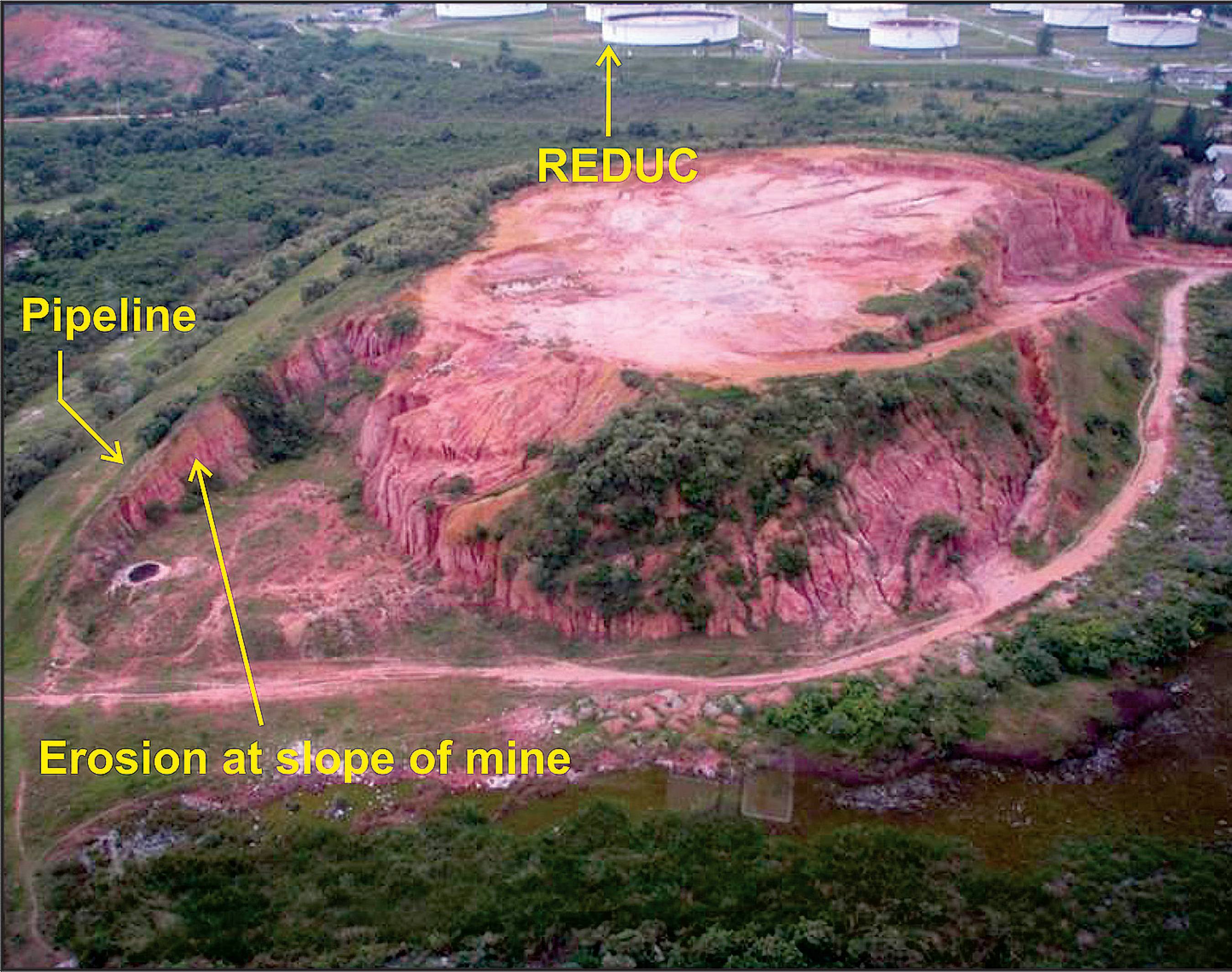Abstract
This study deals with the main environmental impacts and possible mitigation measures for many pipeline tracks, due to the mining of different substances in areas of interference between mining activities and mineral research and those resulting from construction and gas pipeline operation. By monitoring the identified interferences/disturbances, it was determined that although punctual and small in number, the extraction of mineral resources in the proximity of the gas pipelines could represent risks for the security of the undertaking. In general the risks are consequence either of the use of explosives or of induced erosive processes that could lead to pipeline instability. It is necessary to block the mining activities on both sides of the pipeline tracks in order to minimize risks to the pipeline, to others, to society, and to the environment. Also, the establishment of "flexible" track limits could be adopted in areas adjacent to the pipelines for the exploration of some mineral deposits, thus prioritizing security preservation with a minimum of socio-environmental impacts.
Keywords:
gas pipeline; mineral extraction; environmental disturbance
1. Introduction
Gas transport through pipelines together with the research and extraction of minerals in the same area are incompatible to some extent. This situation occurs due to disturbances or negative impacts resulting from the construction or operation of pipelines passing through areas of required mineral exploration. These impacts are due to eventual restrictions and operational impediments that hinder or prevent the continuity of the exploratory activity or cause limitations for the establishment of the real mineral potential of the required area (BIODINÂMICA, 2007BIODINÂMICA ENGENHARIA E MEIO AMBIENTE. Expansão do Gasoduto Rio de Janeiro-Belo Horizonte - GASBEL II: Estudo de impacto ambiental - EIA. Rio de Janeiro, 2007. v.2.). Excavation for research or mineral extraction along the pipeline tracks could cause the rupture of the pipes with risks for the workers and people living around the strip, as well as losses for the company of gas transport, and the whole society that uses this energy.
Mining activities, along with the generation and transportation of different kinds of energy, are considered to be a public utility or social interest and are governed by specific laws, in particular the Decree Laws 3.365/1941 and 227/1967, the Laws 4.132/1962, 9.478/1997 and 12651/2012, the CONAMA Resolution 369/2006, and the Articles 20, 21, 22, 23, 176 and 177 of the Federal Constitution. These legal regulations emphasize that both activities whenever possible must to be conciliated even though there exist opposing interests. The specific legislation, regulation opinions and jurisprudences present the solution for the conflict if there is no agreement.
For more than a decade, researchers of the Applied Geology Department of the Instituto de Geociências e Ciências Exatas of UNESP, Rio Claro (SP) performed surveys about the research activities and ore mining along the strips occupied by the gas pipelines: Bolívia-Brazil, Uruguaiana-Porto Alegre, Campinas-Rio de Janeiro, Cabiúnas-Vitória, Vitória-Cacimbas, Cacimbas-Catu, Cacimbas-Barra do Riacho, Caraguatatuba-Taubaté, Cabiúnas-REDUC, Japeri-REDUC, Paulínia-Jacutinga, Rio de Janeiro-Belo-Horizonte and Maricá-COMPERJ and the strips of the Gas-Chemical UFN-IV and Petrochemical (COMPERJ) complexes. The objective of these surveys was to subsidize the Environmental Impact Studies necessary to obtain the licenses for installing and operating these gas pipelines.
These environmental impact studies intended to approach the interferences of the pipeline tracks with mining and/or mineral research activities since 1997, involving 14 already-constructed pipelines and those in the process of being implanted. These interferences were analyzed regarding the direct influence of the pipeline tracks over an area of 450 m on each side of the pipelines (FERREIRA et al., 2010FERREIRA, G.C., DAITX, E.C., HERRMANN, H., DELL ANTONIO, R. Análise das interferências ambientais e legais entre as atividades de lavra e pesquisa mineral e as de construção e operação de dutos de hidrocarbonetos: aplicação às faixas dos gasodutos Japeri-REDUC, Cabiúnas-REDUC, Cacimbas-Barra do Riacho, Caraguatatuba-Taubaté e Paulínia-Jacutinga. Rio Claro, SP: UNESP/FUNDUNESP, 2010.138 p. (Relatório Final).). Identifying the disturbances caused by mining activities on the pipeline tracks, the company responsible for the pipeline has the chance of managing possible conflicts, avoiding the interruption of the activity and ensuring the integrity for the pipeline's operation. On the other hand, the management of the disturbances due to pipeline track construction over mining activities is also necessary, since it permits the orientation of the technical, administrative and juridical activities related to requisites for environmental licenses, which are gradually increasing in number and becoming more specific. Also necessary is the management of the liabilities associated with mining rights.
Recently, the State Foundation for Environmental Engineering of Rio de Janeiro has begun requiring that surveys demonstrate the impacts of pipeline track construction in areas undergoing mining activities, including the volume of ore reserves to be blocked and its economic impact, similar to the requirements of the Environmental Impact Assessment referring to the gas pipelines located in the state of Rio de Janeiro (Figure 1) (FERREIRA, 2011FERREIRA, G.C. Interferências ambientais e legais entre atividades minerárias e a implantação e operação de gasodutos. Rio Claro: Universidade Estadual Paulista Júlio de Mesquita Filho, 2011. 107 p. (Tese de Livre-Docência).).
Granite body that interferes with the pipeline track. This interference was ignored in the research report for mine's reserve calculation and economic exploitation of the granite body located in Magé County, Rio de Janeiro State (Pipeline Cabiúnas-REDUC (GASDUC III)).
With the objective of identifying and describing the impacts of gas pipeline construction on the various mining activities, this study sought to summarily present the main environmental impacts and the possible mitigating actions to solve the disturbances caused by the mining of different substances close to the pipeline track that were caused by the construction and operation of the gas pipelines over areas of mining and ore research activities.
2. Method
Upon identifying the mineral extraction areas in operation and those with probable future mining activities (including those with mining requests and already-evaluated mineral deposits), monitoring was executed considering the mining method; for the eventual disturbances around the gas pipeline, monitoring was executed by means of aerial and/or field inspections along the pipeline tracks. The monitoring procedures are listed in Table 1.
3. Results and discussion
The impacts caused by the construction and implantation of pipeline tracks over mining activities that were identified during studies are small in number, restricted in area, and with a minimum socio-economic and environmental expression (Ferreira, 2011FERREIRA, G.C. Interferências ambientais e legais entre atividades minerárias e a implantação e operação de gasodutos. Rio Claro: Universidade Estadual Paulista Júlio de Mesquita Filho, 2011. 107 p. (Tese de Livre-Docência).). Table 2 summarizes the main environmental impacts on the pipeline track due to mining, as well as the possible mitigation actions for each type of mineral substance and mining method.
Many areas blocked for future mining activities due to the construction of a gas pipeline contain deposits for usage in civil construction (sand, clay, grit, gravel, and granite). These mineral deposits are considerable in areas surrounding the pipeline track (Ferreira, 2011FERREIRA, G.C. Interferências ambientais e legais entre atividades minerárias e a implantação e operação de gasodutos. Rio Claro: Universidade Estadual Paulista Júlio de Mesquita Filho, 2011. 107 p. (Tese de Livre-Docência).). The main environmental concerns due to mining activities are caused by the extraction of sand and clay in alluvial plains, sand and gravel dredging in river beds, rock blasting with explosives and illegal artisanal mine activities (Figure 2). The environmental impacts caused by these activities along the gas pipeline tracks are generally restricted in area and are of different magnitudes, depending on the mining method used (FERREIRA et al., 2014FERREIRA, G.C., CAETANO-CHANG, M.R., SCALCO, J.P. Interferências entre áreas de mineração e faixas de gasodutos. In: CONGRESSO BRASILEIRO DE GEOLOGIA, 47. Salvador, BA, 2014. Anais... Salvador: SBG, 2014. p. 56.).
Unauthorized grit extraction surrounded by pipelines tracks (Cidade dos Meninos, Duque de Caxias County, Rio de Janeiro State).
Dredging along the river banks can cause erosion at the head of the crossing pipelines, breaking them. In both the mobile and anchored dredging processes, the main environmental impacts caused by these methods of mining are the erosion acceleration on the river banks and the desilting of the river bed, exposing the pipelines. Another impact observed is the use of the gas pipeline track as a place to deposit the material extracted.
In the case of dredging flooded pits, the environmental impacts caused to the pipeline tracks are related to the destabilization of the slopes on the sides of the pits (due to the difficulty to control the dredging), erosion on the sides of the pipeline tracks, implantation of new routes for transporting ore crossing the pipeline tracks, and the use of the strip itself as a means of transporting the ore, and usage as an access route for pipeline maintenance (Figure 3). Furthermore, in the case of liquid hydrocarbonate seepage, this material will directly affect the water table exposed in the pits and in some cases could connect to the local drainage network.
Sand dredging from submersed pits on the floodplain of the Iguaçu River, Curitiba County (Paraná State), that isolate the gas pipeline track Bolívia-Brasil (GASBOL).
Among the mining operations that can cause damage to the pipeline tracks, those related to rock blasting with explosives must be emphasized, due to the vibration of the ground adjacent to the blasting site, causing direct impacts on the pipes and indirect ones on the ground strip, which in turn accelerate landslides of soil and rock layers. Repeated ground vibrations due to frequent use of explosives for rock blasting can accelerate the fatigue of the pipes (FERREIRA, 2011FERREIRA, G.C. Interferências ambientais e legais entre atividades minerárias e a implantação e operação de gasodutos. Rio Claro: Universidade Estadual Paulista Júlio de Mesquita Filho, 2011. 107 p. (Tese de Livre-Docência).).
The extraction of unconsolidated material for use in the maintenance of secondary roads or in landfills is one of the most frequent mining activities along the pipeline tracks, and can cause environmental disturbances along the strips. In the case of open-pit mining, the advance of the extraction fronts in the direction of the gas pipeline tracks should be considered in a way to inhibit the mining activities in the bordering areas, since these areas could serve as destabilization points of the neighboring slopes, thus preventing the installation or acceleration of erosive processes that could affect the pipelines (Figure 4).
Grit extraction in the Duque de Caxias County (Rio de Janeiro State), close to the gas pipeline track Japeri-REDUC. The mining works extended to the boundary of pipeline track.
4. Conclusions
As a preventive action, it is interesting to require of the environmental entities, when applicable, studies about the possible impacts on the security of the gas pipeline.
As one of the principal results of the performed surveys, there is the need to block the mining activities on the sides of the pipeline tracks in order to minimize risks to the pipeline, to others, to society, and to the environment. This blocking aims to preserve the continuity of the pipeline activity, which ensures the supply of energy and the hydrocarbonate transport in accordance to the norms and standards for security.
Among the mitigating actions, the establishment of "flexible" strip limits for the exploration of some mineral deposits could be adopted in areas adjacent to the pipeline, thus prioritizing security preservation with a minimum of socio-environmental impact. In the case of rock extraction using explosives, the settlement of the width of the strip depends on the mining method to be adopted for each deposit, and should be established based on technical parameters obtained from specific studies and in accordance with the Brazilian standards ABNT NBR 9653:2005ABNT-ASSOCIAÇÃO BRASILEIRA DE NORMAS TÉCNICAS NBR 9653:2005 Guia para avaliação dos efeitos provocados pelo uso de explosivos nas minerações em áreas urbanas. Rio de Janeiro, 2005. 11 p.. In the case of mobile dredging on river bed and mineral water exploitation, the interferences should be analyzed case by case, since their features are peculiar.
The management of pipeline track interferences with mining activities is very important, since it supplies data for the technical, administrative and juridical orientation for compliance the conditions of environmental licenses and management of the liabilities associated with mining rights.
5. References
- ABNT-ASSOCIAÇÃO BRASILEIRA DE NORMAS TÉCNICAS NBR 9653:2005 Guia para avaliação dos efeitos provocados pelo uso de explosivos nas minerações em áreas urbanas Rio de Janeiro, 2005. 11 p.
- BIODINÂMICA ENGENHARIA E MEIO AMBIENTE. Expansão do Gasoduto Rio de Janeiro-Belo Horizonte - GASBEL II: Estudo de impacto ambiental - EIA. Rio de Janeiro, 2007. v.2.
- FERREIRA, G.C. Interferências ambientais e legais entre atividades minerárias e a implantação e operação de gasodutos Rio Claro: Universidade Estadual Paulista Júlio de Mesquita Filho, 2011. 107 p. (Tese de Livre-Docência).
- FERREIRA, G.C., DAITX, E.C., HERRMANN, H., DELL ANTONIO, R. Análise das interferências ambientais e legais entre as atividades de lavra e pesquisa mineral e as de construção e operação de dutos de hidrocarbonetos: aplicação às faixas dos gasodutos Japeri-REDUC, Cabiúnas-REDUC, Cacimbas-Barra do Riacho, Caraguatatuba-Taubaté e Paulínia-Jacutinga. Rio Claro, SP: UNESP/FUNDUNESP, 2010.138 p. (Relatório Final).
- FERREIRA, G.C., CAETANO-CHANG, M.R., SCALCO, J.P. Interferências entre áreas de mineração e faixas de gasodutos. In: CONGRESSO BRASILEIRO DE GEOLOGIA, 47. Salvador, BA, 2014. Anais... Salvador: SBG, 2014. p. 56.
Publication Dates
-
Publication in this collection
Apr-Jun 2016
History
-
Received
09 Sept 2015 -
Accepted
01 Apr 2016





